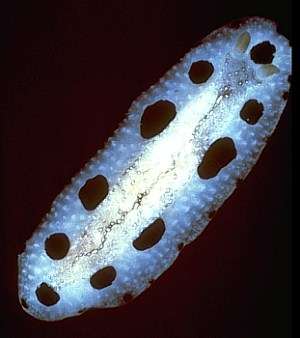
Phyllidiopsis loricata
(Bergh, 1873)
Order: NUDIBRANCHIA
Suborder: DORIDINA
Family: Phyllidiidae
DISTRIBUTION
Known from the Great Barrier Reef, Timor Sea (northern Australia), Guam, the Marshall Islands, Enewetok Atoll and the type locality, Tahiti.
PHOTO
Collected intertidally, Mandora Point, Darwin, NT, November 1972, dorsal view of 40 mm specimen, Photo: N. Coleman (Brunckhorst, 1993: Plate 8C).
Notes compiled from Brunckhorst, 1993:
Phyllidiopsis loricata is distinguished by the following: its white dorsum with black to dark brown spots; rough mantle surface; pointed white rhinophores with 16-19 lamellae on each clavus (specimens greater than 15 mm); white ventral coloration; and large, square shaped oral tentacles.
Phyllidiopsis phiphiensis, Phyllidiopsis annae and Phyllidiopsis striata possess white and black coloration but differ considerably in being striped. Phyllidiopsis loricata is superficially similar to Phyllidia scottjohnsoni
which has large black spots, medially, on a pale cream-white background. It is difficult to separate these two species on external characters alone. The main external features which differentiate the two species are the lack of spots mid-dorsally and the large, fused, square oral tentacles of the present species. Phyllidiopsis loricata has a greater number of lamellae on the rhinophoral clavus than Phyllidia scottjohnsoni.
Reference:
• Brunckhorst, D.J. (1993) The systematics and phylogeny of Phyllidiid Nudibranchs (Doridoidea). Records of the Australian Museum, Supplement 16: 1-107.
Rudman, W.B., 1999 (August 1) Phyllidiopsis loricata (Bergh, 1873). [In] Sea Slug Forum. Australian Museum, Sydney. Available from http://www.seaslugforum.net/factsheet/phyllori
Related messages
-
Re: Phyllidiopsis loricata from southern Queensland
From: Gary Cobb, June 9, 2007 -
Phyllidiopsis loricata from southern Queensland
From: Gary Cobb, June 8, 2007 -
Phyllidiopsis loricata from Reunion Island
From: Philibert Bidgrain, November 1, 2005 -
Phyllidiopsis loricata from Hawaii
From: Keoki Stender, September 24, 2003
